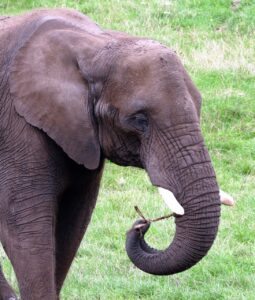 As an outdoor educator in the late ‘80s I remember hiking with a group of energetic 5th graders in a lesson called Coming to Conclusions. The idea was to notice unusual things in nature and then announce an inference to the group – a conclusion based on evidence and reasoning – of what was being observed. As we chatted about shelf fungus, twisted trees, and animal scat, the kids were complaining of burrs stuck to their socks. A teacher shared that we were looking at an excellent example of biomimicry. Using a hand lens we looked more closely at the burdock as she explained it was the inspiration for a new way of fastening clothes – Velcro! It was my first introduction to biomimicry, the fascinating world of nature-inspired engineering design.
As an outdoor educator in the late ‘80s I remember hiking with a group of energetic 5th graders in a lesson called Coming to Conclusions. The idea was to notice unusual things in nature and then announce an inference to the group – a conclusion based on evidence and reasoning – of what was being observed. As we chatted about shelf fungus, twisted trees, and animal scat, the kids were complaining of burrs stuck to their socks. A teacher shared that we were looking at an excellent example of biomimicry. Using a hand lens we looked more closely at the burdock as she explained it was the inspiration for a new way of fastening clothes – Velcro! It was my first introduction to biomimicry, the fascinating world of nature-inspired engineering design.
Biomimicry is the science of seeing nature as a model that inspires ideas to solve human problems. Janine Benyus, an American natural sciences writer and innovation consultant, popularized the term in her book Biomimicry: Innovation Inspired by Nature. Biomimicry is the practice of learning how to mimic nature’s greatest success stories and to use this knowledge in design thinking for a better world. Her definition of biomimicry is the “conscious emulation of life’s genius”. Intentional. Applied insights. Life’s living things’ adaptations that have stood the test of time.
Youth are captivated by biomimicry because it is relatable. The unique structure of a woodpecker’s skull (and its resilience to a daily beating as the bird hammers away seeking insects embedded in the bark of a tree) inspired the design of their bike helmet! Kids are amazed by their remarkable speed using swim fins in the pool and totally get the connection to a ducks’ webbed feet. A whale is an obvious model for a submarine silently plying the ocean. Youth can see adaptations in everyday life: dandelion seeds float, dogs have great noses, turtles have a hard carapace, roses have thorns…with many offering cool applications to human needs.
According to the Biomimicry Institute (https://biomimicry.org/) educators can initiate interest in biomimicry by encouraging youth to ask, “What do I want my design to do? What function do I want to solve for?” Once the goal is clear, youth can explore species where that function successfully exists and apply strategies to design a new product, process or system. When youth understand ecosystems and the living things in it, they can grasp an engineer’s reasons for wanting to learn all they can about a specific species and how it meets its needs with specialized functioning parts. Kids can ask, “How does it move, get energy, see, reproduce or avoid becoming another species’ meal”? Over time, when youth hone their observation skills, they get past what something looks like, but instead unpack how it functions. As they become more astute observers, youth can begin to understand patterns that make up earth’s complex systems. Youth understand that all species adapt for survival. And nature has been doing it, successfully, for millennia in an effort to maintain a balanced, healthy planet.
Unfortunately, humans have been interfering with the earth and its systems in ways that may now be irreversible. We have come to think of ourselves as apart from nature, not a part of nature. Biomimicry turns this idea around. If we pay attention, we can see how species and whole ecosystems can recover and that we depend on nature for our very existence. Biomimicry gives humans hope to solve complex problems including applications for medical treatments, efficient transportation, heating and cooling our homes, and agriculture technologies to feed an ever-growing population.
Engineers all over the world are making strides through biomimicry by looking at biological models. They might engage in the practice of “reverse engineering” – dismantling an object or process to see how it works. When we understand the mechanism of how an adaptation functions, we can adjust its design for human needs, ideally ones that are sustainable. The intersection of biology and engineering gets interesting here. Observing living things often requires getting down to a molecular level to see the chemical and physical elements that allow it to function for survival. Scientists must use deductive reasoning to understand what is going on, often with very little insight into how, exactly, a species does what it does!

From elephant trunks that inspired flexible robotic prosthetic limbs to pitcher plants that inspired traps for edible, high-protein food insects biomimicry is everywhere. If you are an educator working with youth in STEM, show them some images of biomimicry-inspired innovations and arm your kids with hand lenses and explore a nearby park, woods, meadow or natural area. Ask a scientist to talk about biomimicry and why it is so cool! For middle and high school youth, a great way to engage them is to check out the 2022 – 2023 Youth Design Challenge https://youthchallenge.biomimicry.org/ And always, revel in the beauty and awe-inspiring species that could hold the key to the next great invention.
